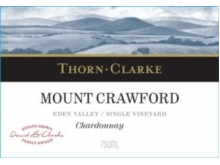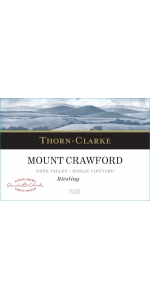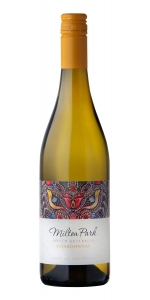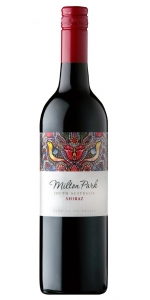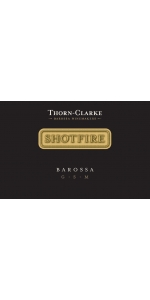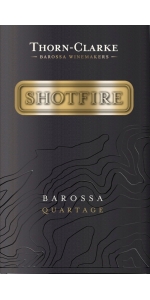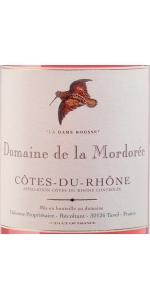Thorn Clarke Mt. Crawford Chardonnay 2017
| Country: | Australia |
| Region: | Eden Valley |
| Winery: | Thorn Clarke - Mount Crawford |
| Grape Type: | Chardonnay |
| Vintage: | 2017 |
| Bottle Size: | 750 ml |
This Thorn Clarke Mt. Crawford Riesling is a fine example of Mount Crawford climate, soil and aspect combining to display a varietal bouquet of spicy floral characters. With fresh, crisp citrus notes and a long finish on the palate, this wine can be enjoyed with a vast array of foods. The winemaker recommends enjoying this with spicy tandoori chicken.
This Thorn Clarke Mt. Crawford Riesling is a fine example of Mount Crawford climate, soil and aspect combining to display a varietal bouquet of spicy floral characters. With fresh, crisp citrus notes and a long finish on the palate, this wine can be enjoyed with a vast array of foods. The winemaker recommends enjoying this with spicy tandoori chicken.
Thorn Clarke Milton Park Chardonnay grapes were crushed, destemmed and then pressed using a membrane press. Pressings were not used. Fermented using French Yeast at 12-15 degrees Celcius. The ferment was kept slow and cool to retain all the natural flavors of the grape. The wine was then racked and filtered. Bottling took place soon afterwards so the wine was a true expression of the grape and the terroir from which it was made.
The color is a rich vibrant green. The nose shows lifted clean, sweet fruit of apricot and peach. The palate is medium to full bodied and exhibits predominantly peach and nectarine flavors, with cloves and cardamom evident from the use of a small amount of French oak. The wine finishes full and long with a nice balance of sweet fruit and creaminess.
Thorn Clarke Milton Park Shiraz is aged for 12 months in American oak barrels.
Deep red color. The wine is deep and rich smelling with dark fruits, plums and spice with some good oak. There is very rich fruit on the palate with plums, blackberry and sweet spice from the oak. The palate is vibrant and young with a flavorsome viscous mouthfeel which will develop complexity with time. There are some slightly chewy tannins which will soften with time and there is great length of fruit flavor.
Thorn Clarke Shotfire GSM is made from 51% Grenache, 39% Shiraz, 10% Mourvedre.
The Shotfire range honors a family pioneer who worked the Barossa goldfields in the late 1800's. He had the hazardous job of being a 'Shotfirer'; one who handled the explosives to be used in finding that rich vein of gold.
A classic blend of the traditional stalwarts from the Barossa, this blend of Grenache, Shiraz and Mourvèdre is sourced from older low yielding vines.
Bright crimson in color with purple highlights at the edge of the glass. The nose is lifted and draws you in with ripe plum, mulberry and white pepper. The palate is plush and vibrant with cherries, forest fruits and enticing spice. As silky and smooth as it is complex and savory - the wine is beautifully balanced and juicy with great structure and generous mouthfeel. This classic GSM finishes with long, velvety tannins.
Each variety was destemmed and fermented separately - in small 6 tonne open fermenters - to allow full expression of varietal character. To ensure optimum extraction of tannins, color and flavor the Grenache was pumped over twice daily for a duration of 10 days and both the Shiraz and Mourvedre spent 7 days on skins with pump overs twice daily. Fermentation temperatures were maintained between 22-25 degrees to retain fruit purity. All batches were pressed off and once both primary alcoholic fermentation and secondary malolactic fermentation were complete the wines were then racked to new (10%) and 10 year old French hogsheads where the wines matured for a period of 18 months. Bench blends were created to ensure a harmonious final wine.
Pairs best with slow Cooked Lamb or Roasted Vegetable Medley.
Thorn Clarke Shotfire Quartage is made from 58% Cabernet Sauvignon, 16% Cabernet Franc, 16% Merlot, 10% Petit Verdot.
.
The fruit was harvested at night. Fermentation was carried out in a variety of small capacity fermenters. After pressing the parcels were filled to French oak (12 months) for maturation. The wine was racked after six months and the parcels were blended to form the final wine.
Shotfire Quartage is based on the five traditional red varieties found in the Bordeaux region of France (Cabernet Sauvignon, Merlot, Cabernet Franc, Petit Verdot and Malbec). The Thorn-Clarke winemakers use at least four of the varieties to create the blend each year (occasionally, they can get over excited and use all five). The blend is a reminder to not only look to the future but also to keep an eye on the past and tradition.
Much like the previous vintage, the 2020 harvest has produced wines of immense quality but with very low quantities. Another dry winter and mild weather during the ripening period lead to great varietal flavours and excellent tannin structure. Upon harvest the bunches were few and far between and the berries themselves small. This led to fruit with intense flavor and color along with great power and balance.
This generous blend boasts a rich deep red-purple color. Aromas of blackberries, satsuma plum and anise fill the glass. On the palate, plush tannins are accompanied by rich notes of cassis and blackcurrant. Together they produce a wine with lavish density, complexity and length. A wine that can be enjoyed now or laid down to age for many years.
The Shotfire range honors a family pioneer who worked the Barossa goldfields in the late 1800's. He had the hazardous job of being a 'Shotfirer'; one who handled the explosives to be used in finding that rich vein of gold.
Thorn Clarke Mount Crawford Chardonnay is made from 100 percent Chardonnay.
This Chardonnay is a fine example of Mount Crawford climate, soil and aspect combining to display great varietal characters. The light green color has a vibrancy that is characteristic of the wine. Peach and tropical fruit flavors are complemented by a creamy texture from lees contact and a small amount of exposure to French oak. This also gives the wine a rich, long but clean finish with delicious white peach, pear and citrus notes.
The winemaker recommends trying this wine with chicken teppanyaki.
The Thorn Clarke Estate
The winery owners are David and Cheryl Clarke (born Thorn) and their son Sam is the manager of the winery. The Thorn-Clarke family has a long history in the Barossa - six generations of involvement in the region's world famous wine industry. The Thorns have been grape growers in the Barossa since the 1870's. David Clarke's passion for the wine industry lead to the planting of the Kabininge vineyard outside of Tanunda in 1987, which represents the start of a deeper involvement by the family in the Barossa wine industry.
The Thorn Clarke Vineyards
Eden Valley is one of Australia's oldest and most respected white wine regions, and within the Eden Valley the Mount Crawford block is recognized for its particularly cold climate. The cooler conditions of this sub-region, combined with nutrient-poor residual soils and a northern aspect, create an environment ideal for growing white grape varieties. Vines are restricted from growing too vigorously or ripening too quickly ensuring the grapes develop wonderful flavor and character.
Mordoree Cotes du Rhone Dame Rousse Rose is made from 40% Grenache, 35% Syrah, 15% Cinsault, 5% Carignan, 5% Mourvèdre
Color : rosé, slightly orange (mordorée colour).
Aromas : crystallized oranges and cherries, slightly aniseed.
Palate : very rounded, fresh and long finish.
Ageing potential : 2 to 3 years
Surface : 14 Ha. Yield : 45 Hl./Ha. Vineyard age : 20 years Terroir : clay / chalk,clay / limestone and sandy with pebble stones. Harvest : by hand. Vinification : vat bleeding, temperature control. Estate bottled.
Food pairing: cold meats and delicatessen, fowl, white meats, grilled lamb with Provence herbs, fish soup, fried fish, pastas, pizzas and all Asian dishes.
Review:
"This rosé appears so pretty in the glass with its watermelon hue and presents a refreshing summery nose. Find notes of watermelon slices and yellow peaches sprinkled with sea salt. Think of pairings similar to prosciutto-wrapped melon. This is a solid rosé to enjoy all summer long."
- Wine Enthusiast (May 2023), 91 pts
Zombie Zin Zinfandel is made from 95% Zinfandel and 5% Syrah
Be careful if you go out at night. The Zombie Zin is designed to be consumed in hiding with the only friends you have left... post apocalypse.
The Zombie Zin is sporting a new label design with a torn look, that suggests a window into another world. The colors are more vibrant earth-tones and the capsule is a deep red.
The Zombie Zinfandel is very dark in color, almost a black-purple. The aromas are of ripe, dense black fruits and a hint of dried herbs. The flavors are complex and rich, sporting succulent blackberries, powdered cinnamon, cola and cherry jam. Just a hint of black pepper in the long finish.
The grapes for the Zombie are sourced throughout California, mostly from the dry, hot sandy soils of the Delta region and the Central Valley. The final blend benefitted from some inky Syrah grapes that came from the Central Coast. The wine was fermented in Stainless Steel and aged for about a half a year in American oak.
Pairs well with bloody BBQ meats, sinister soups with eye of newt, bubbly caldron of fleshy stew.
- back
Chateau de Saint Cosme Gigondas is made from 70% Grenache, 15% Mourvèdre, 14% Syrah, 1% Cinsaut.
The wine shows intense blackberry and fig fruit with licorice, violets, and charcoal on the finish. It is remarkably fresh and finessed given the sun and warmth of the southern Rhône. The unique micro-climate combined with 60-year-old vines and traditional winemaking make Château de Saint Cosme Gigondas the benchmark wine of the appellation.
Review:
Leading off the Gigondas, the base 2020 Gigondas has lots of black raspberry, ground pepper, and violets notes as well as a round, supple, silky style on the palate. It should be approachable on release, yet it has plenty of mid-palate depth as well as tannins, and I have no doubt it will evolve for 20 years if properly stored.
-Jeb Dunnuck 91-93 Points
Siegel San Elias Carmenere is made from 100 percent Carmenere.
The nose shows beautiful red and dark fruit aromas, earthy notes and violets with balanced acidity. Supple and round in the mouth, juicy tannins, good concentration.
Pairs well with pasta dishes, Mediterranean cuisine and grilled vegetables.

